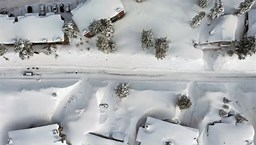
One Crazy Winter
So what kind of winter have you had, wherever you are in this great nation of ours?
Out here — in the Great State of California — here’s what we’ve faced so far this winter — with still a few days to go before spring shows up on your calendar and ours.
Eleven — yes, 11 — “atmospheric rivers” have drenched and drowned many areas of our San Joaquin Valley — and buried the Sierra with so much snow it’s almost unfathomable.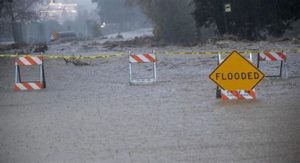
First, the rain. So much has fallen in our Valley that creeks, streams and rivers have turned into raging and dangerous torrents. Thousands of people have been evacuated — as waterways in towns such as Merced and Planada and Porterville overflowed into their neighborhoods and flooded their homes.
In Monterey County — about 150 miles away on the coast — the town of Pajaro was nearly destroyed when a levee burst, letting water from the Pajaro River inundate neighborhood after neighborhood.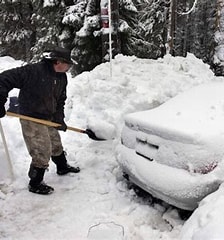
Now, for the snowfall. There’s been a ton of it. Try 650 inches at our highest elevations. That’s 51 feet, my friends.
So much snow — even at relatively low levels — that it trapped many people inside their mountain homes because the snow was above their windows and blocked their doors. They could not escape, and when the power went out in their places, more than two dozen people died.
The storms resulted in blizzard warnings in the Southern California mountains — something that almost never happens. Yosemite National Park was shut down for days. Foothill and mountain communities just a few miles east of our place in Tesoro Viejo were isolated because roads in and out were made impassable by snow or overflowing waterways that flooded them.
It’s been one of the wettest, snowiest winters in California’s history. In recent decades, only the 1983 winter season matches this one. Sharon and I have no memory of that one because we were in the midst of our years-long treks to new jobs and new cities. We lived in both Detroit and Buffalo in ’83. (Yes. Imagine living in both of those beauties in the course of just one calendar year. My, my.)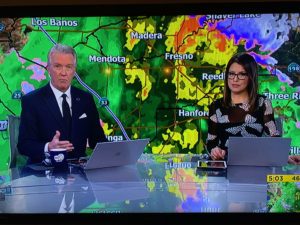
We’ve had so many wild weather days here in the Valley this year that our No. 1 TV station in Fresno — KFSN-TV, Channel 30 — has regularly opened its newscasts with either a “breaking news” sounder or an “AccuWeather alert.” The station came up with the visually stunning idea of putting live radar completely behind its anchors — so we could all see, easily, where the rain and snow were falling at that moment.
Often, there were so many “hot spots” around the Valley in terms of flooding and evacuations — and thus, the need for numerous live shots by Channel 30 — that its Action newscasts would open with a “quint split.” TV people love those. That means the anchors are in one box — and four live reporters are in four other boxes, all on the screen at the same time.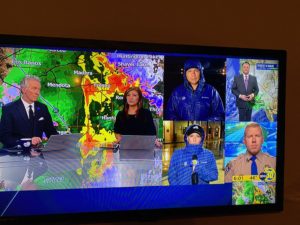
As an old TV guy — who started at Channel 30, by the way — this was exciting to watch. Yes, even at my age. I still love it when 30 — which has more money and more resources by far than the other stations — wheels out everything it has on major-story coverage. And it has a lot.
But back to bad winters. As I said, before my mind diverted to a sideshow — we were not here in 1983. But we were here in the winter of ’69 — and that was a bad one. Flooding. Tons of snowfall.
And all this is, really, a normal pattern for California.
We keep going through cycles of tremendous rain and snow — and extreme drought. It’s been this way ever since weather records have been kept.
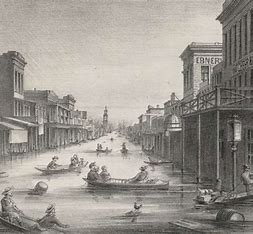 When Leland Stanford — yes, as in “Stanford University” (he founded it) — was sworn in as governor on that January day in 1862 in Sacramento, he had to take a rowboat to his inauguration. The entire city was underwater — the biggest flood in state history — and the Sacramento and San Joaquin rivers had formed a huge inland sea.
When Leland Stanford — yes, as in “Stanford University” (he founded it) — was sworn in as governor on that January day in 1862 in Sacramento, he had to take a rowboat to his inauguration. The entire city was underwater — the biggest flood in state history — and the Sacramento and San Joaquin rivers had formed a huge inland sea.
Over the past century-and-a-half, the state has tried — oh, it’s tried — to contain flood waters and to manage the flow of water from Northern California — where the rain falls — to usually dry Southern California. We created the State Water Project, and the feds created the Central Valley Project. Both involved dams and reservoirs and canals.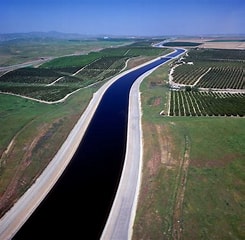
And for the most part, it’s worked. Rivers rarely flood anymore (except, of course, in extraordinary years like this). Dams have been built up and down California, creating reservoirs that provide both summer recreation and a supply of water for farmers and cities — in that order.
Both of the projects — the federal and state ones — helped create modern Southern California because water could flow over the Tehachapi Mountains from the north, through the Valley into SoCal. It was a marvel of engineering.
That water also created the agriculture industry on the Valley’s west side. Unfortunately, for all the good those projects brought to the state — there were, and are, negatives.
Farmers on the west side of the Valley have used that canal water to irrigate land that never should have been used for farming. It really was only good for grazing. But when they planted cotton and cantaloupes and pistachios and almond trees — they created a cycle of need for themselves and their crops.
And when the drought years show up –as they always do — and the feds and state have to limit the water flow to conserve as much as possible — the farmers get into a bind. Where can they get the water they need to sustain their thirsty trees and crops?
They get it by drilling wells — thousands of wells, thousands of feet deep. So many wells sucking up so much of our underground aquifer that much of the Valley is now subsiding. The ground is collapsing — compacting — above our diminishing aquifer. And wells are drying up — so farmers keep drilling deeper.
Those farmers continue to cry, in dry years, about how they need more water. And environmentalists — who hate how much water farmers get in any year — keep crying about fish and wildlife. And never the two shall meet. No compromise seems possible, but it’s clear that farmers will have to make adjustments to their crops. It’s just not sustainable to keep planting water-needy crops on land that doesn’t reliably have it.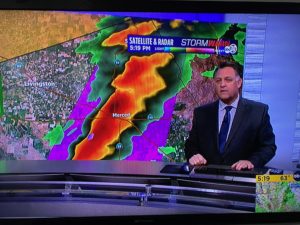
But back to this particular wild winter. Channel 30’s weather guy — the very able Kevin Musso — has been on the air more this winter than he ever has — more than any reporter and almost as much as the anchors. Kevin is proving what TV news directors have long known — the weather person is a quite important member, indeed, of on-air TV teams.
The reason is simple — weather affects everyone, and everyone watches for it. That house fire down the street doesn’t cut it in terms of viewers’ needs. Neither does that “important” city council meeting the audience yawns at before it tunes out.
So here we are, — a few days away from the official start of spring — and Kevin says another atmospheric river may well show up to inundate us early next week. That would be our 12th such river since December — but our first one in spring.
Oh, my. I sure hope that — as summer approaches — I won’t be writing a piece on this blogsite that I call “One Crazy Spring.”
That would be — well, crazy.
